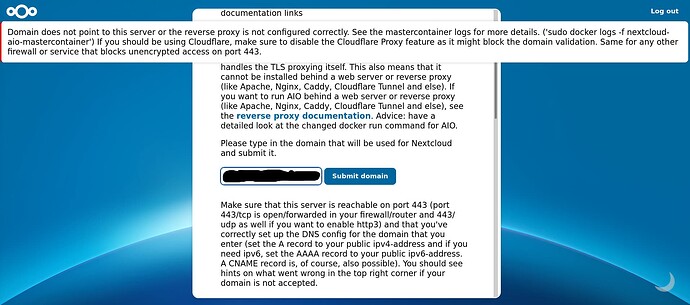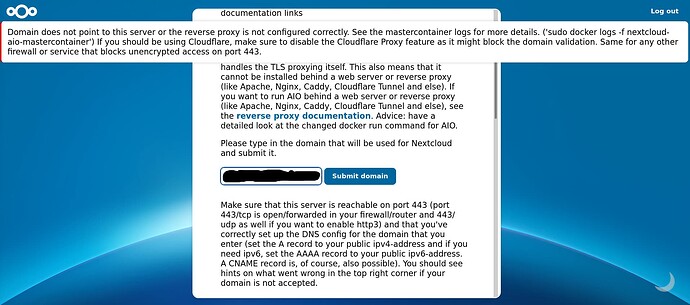The Basics
- Nextcloud Server version (e.g., 29.x.x):
Nextcloud AIO v11.8.8
- Operating system and version (e.g., Ubuntu 24.04):
Debian 12
- Web server and version (e.g, Apache 2.4.25):
AIO installation with docker
- Reverse proxy and version _(e.g. nginx 1.27.2)
NA
- PHP version (e.g, 8.3):
NA
- Is this the first time you’ve seen this error? (Yes / No):
Yes
- When did this problem seem to first start?
At installation
- Installation method (e.g. AlO, NCP, Bare Metal/Archive, etc.)
AIO
- Are you using CloudfIare, mod_security, or similar? (Yes / No)
No
Summary of the issue you are facing:
I am trying to setup a NextCloud server on my Linux machine that I am running a VPN on.
The way I am going about it is that:
I made a DDNS account on deSEC and got a domain for that, installed it using ddclient and checked it with ping and it’s up and running.
Now the problem happens when i try to enter this domain in the setup page of NextCloud.
I get this error:
Domain does not point to this server or the reverse proxy is not configured correctly. See the mastercontainer logs for more details. (‘sudo docker logs -f nextcloud-aio-mastercontainer’) If you should be using Cloudflare, make sure to disable the Cloudflare Proxy feature as it might block the domain validation. Same for any other firewall or service that blocks unencrypted access on port 443.
Also attached in the image:
Now how can I overcome this error and get to the next page successfully?
Info that might help:
-
I am using Debian 12.
-
And the NextCloud will be installed on my main computer that has a running VPN on it that I don’t want to disconnect.
-
The VPN provider offer port forwarding but i can’t select a specific port
Steps to replicate it (hint: details matter!):
-
Install Next cloud using the steps from the official github repo:
GitHub - nextcloud/all-in-one: 📦 The official Nextcloud installation method. Provides easy deployment and maintenance with most features included in this one Nextcloud instance.
The installation process is completed successfully and easily and i can access the Setup page through https://localhost:8080 -
After opening the very first page of the wizard and entering my domain that i created successfully using deSEC and tested it using: ping nc.myexample.domain
-
I get this error:
Domain does not point to this server or the reverse proxy is not configured correctly. See the mastercontainer logs for more details. (‘sudo docker logs -f nextcloud-aio-mastercontainer’) If you should be using Cloudflare, make sure to disable the Cloudflare Proxy feature as it might block the domain validation. Same for any other firewall or service that blocks unencrypted access on port 443.
Log entries
Nextcloud
Please provide the log entries from your Nextcloud log that are generated during the time of problem (via the Copy raw option from Administration settings->Logging screen or from your nextcloud.log located in your data directory). Feel free to use a pastebin/gist service if necessary.
Not applicable as i haven't finished the wizard yet
Web Browser
If the problem is related to the Web interface, open your browser inspector Console and Network tabs while refreshing (reloading) and reproducing the problem. Provide any relevant output/errors here that appear.
NA
Web server / Reverse Proxy
The output of your Apache/nginx/system log in /var/log/____:
NA
Configuration
The “Log files”:
This is the closest thing to a “log file” i could found in my case by running this command in the terminal:
docker logs -f nextcloud-aio-mastercontainer
The output:
Trying to fix docker.sock permissions internally...
Creating docker group internally with id 135
...+......+....................+.+......+...+..+.........+.+.........+.....+......+...+......+....+++++++++++++++++++++++++++++++++++++++++++++*...+.....+...+.+......+...+.....+...+....+........................+.....+......+......+..........+.....+++++++++++++++++++++++++++++++++++++++++++++*......+........+.........+.+........+.......+...+.........+........+.......+...............+.................+...+.+.....+.+........+......+...................+......+.........+..................+..+......+.........+.......+..............+......+................+............+...+.......................................+.........+......+........+.......+...+..+...+++++
.....+.........+.....+.......+.....+....+......+++++++++++++++++++++++++++++++++++++++++++++*..+....+...+...+............+...+...+.....+....+..+++++++++++++++++++++++++++++++++++++++++++++*...........+.........+......+...............+....+..+.......+...+...+..+........................+.........+.+...+.......................+.........+...+.+..+....+.........+..........................+...+.......+........+++++
-----
Initial startup of Nextcloud All-in-One complete!
You should be able to open the Nextcloud AIO Interface now on port 8080 of this server!
E.g. https://internal.ip.of.this.server:8080
⚠️ Important: do always use an ip-address if you access this port and not a domain as HSTS might block access to it later!
If your server has port 80 and 8443 open and you point a domain to your server, you can get a valid certificate automatically by opening the Nextcloud AIO Interface via:
https://your-domain-that-points-to-this-server.tld:8443
/usr/lib/python3.12/site-packages/supervisor/options.py:13: UserWarning: pkg_resources is deprecated as an API. See https://setuptools.pypa.io/en/latest/pkg_resources.html. The pkg_resources package is slated for removal as early as 2025-11-30. Refrain from using this package or pin to Setuptools<81.
import pkg_resources
{"level":"info","ts":1758373617.5402346,"msg":"maxprocs: Leaving GOMAXPROCS=8: CPU quota undefined"}
{"level":"info","ts":1758373617.5404062,"msg":"GOMEMLIMIT is updated","package":"github.com/KimMachineGun/automemlimit/memlimit","GOMEMLIMIT":22582473523,"previous":9223372036854775807}
{"level":"info","ts":1758373617.540444,"msg":"using config from file","file":"/Caddyfile"}
{"level":"info","ts":1758373617.5417027,"msg":"adapted config to JSON","adapter":"caddyfile"}
{"level":"info","ts":1758373617.543201,"msg":"serving initial configuration"}
[Sat Sep 20 13:06:57.655984 2025] [mpm_event:notice] [pid 171:tid 171] AH00489: Apache/2.4.65 (Unix) OpenSSL/3.5.2 configured -- resuming normal operations
[Sat Sep 20 13:06:57.656064 2025] [core:notice] [pid 171:tid 171] AH00094: Command line: 'httpd -D FOREGROUND'
[20-Sep-2025 13:06:57] NOTICE: fpm is running, pid 176
[20-Sep-2025 13:06:57] NOTICE: ready to handle connections
Deleting duplicate sessions
NOTICE: PHP message: The response of the connection attempt to "http://my.domain55name.dedyn.io:443" was:
NOTICE: PHP message: Expected was: b1c...................................f
NOTICE: PHP message: The error message was: Operation timed out after 10001 milliseconds with 0 bytes received
NOTICE: PHP message: The response of the connection attempt to "http://my.domain55name.dedyn.io:443" was:
NOTICE: PHP message: Expected was: b1c...................................f
NOTICE: PHP message: The error message was: Operation timed out after 10002 milliseconds with 0 bytes received
NOTICE: PHP message: The response of the connection attempt to "http://my.domain55name.dedyn.io:443" was:
NOTICE: PHP message: Expected was: b1c...................................f
NOTICE: PHP message: The error message was: Operation timed out after 10001 milliseconds with 0 bytes received
NOTICE: PHP message: The response of the connection attempt to "http://my.domain55name.dedyn.io:443" was:
NOTICE: PHP message: Expected was: b1c...................................f
NOTICE: PHP message: The error message was: Operation timed out after 10002 milliseconds with 0 bytes received
NOTICE: PHP message: The response of the connection attempt to "http://my.domain55name.dedyn.io:443" was:
NOTICE: PHP message: Expected was: b1c...................................f
NOTICE: PHP message: The error message was: Operation timed out after 10002 milliseconds with 0 bytes received
NOTICE: PHP message: The response of the connection attempt to "http://my.domain55name.dedyn.io:443" was:
NOTICE: PHP message: Expected was: b1c...................................f
NOTICE: PHP message: The error message was: Operation timed out after 10002 milliseconds with 0 bytes received
NOTICE: PHP message: The response of the connection attempt to "http://my.domain55name.dedyn.io:443" was:
NOTICE: PHP message: Expected was: b1c...................................f
NOTICE: PHP message: The error message was: Operation timed out after 10002 milliseconds with 0 bytes received
NOTICE: PHP message: The response of the connection attempt to "http://my.domain55name.dedyn.io:443" was:
NOTICE: PHP message: Expected was: b1c...................................f
NOTICE: PHP message: The error message was: Operation timed out after 10002 milliseconds with 0 bytes received
NOTICE: PHP message: The response of the connection attempt to "http://my.domain55name.dedyn.io:443" was:
NOTICE: PHP message: Expected was: b1c...................................f
NOTICE: PHP message: The error message was: Operation timed out after 10002 milliseconds with 0 bytes received
NOTICE: PHP message: The response of the connection attempt to "http://my.domain55name.dedyn.io:443" was:
NOTICE: PHP message: Expected was: b1c...................................f
NOTICE: PHP message: The error message was: Operation timed out after 10002 milliseconds with 0 bytes received
Deleting duplicate sessions
NOTICE: PHP message: The response of the connection attempt to "http://my.domain55name.dedyn.io:443" was:
NOTICE: PHP message: Expected was: b1c...................................f
NOTICE: PHP message: The error message was: Operation timed out after 10002 milliseconds with 0 bytes received
NOTICE: PHP message: Could not get digest of container nextcloud-releases/aio-domaincheck:latest cURL error 6: Could not resolve host: ghcr.io (see https://curl.haxx.se/libcurl/c/libcurl-errors.html) for https://ghcr.io/token?scope=repository:nextcloud-releases/aio-domaincheck:pull
NOTICE: PHP message: Not pulling the ghcr.io/nextcloud-releases/aio-domaincheck image for the nextcloud-aio-domaincheck container because the registry does not seem to be reachable.
NOTICE: PHP message: Could not get digest of container nextcloud-releases/all-in-one:latest cURL error 6: Could not resolve host: ghcr.io (see https://curl.haxx.se/libcurl/c/libcurl-errors.html) for https://ghcr.io/token?scope=repository:nextcloud-releases/all-in-one:pull
NOTICE: PHP message: Could not get digest of container nextcloud-releases/all-in-one:latest cURL error 6: Could not resolve host: ghcr.io (see https://curl.haxx.se/libcurl/c/libcurl-errors.html) for https://ghcr.io/token?scope=repository:nextcloud-releases/all-in-one:pull
NOTICE: PHP message: Could not get digest of container nextcloud-releases/all-in-one:latest cURL error 6: Could not resolve host: ghcr.io (see https://curl.haxx.se/libcurl/c/libcurl-errors.html) for https://ghcr.io/token?scope=repository:nextcloud-releases/all-in-one:pull
NOTICE: PHP message: Could not get digest of container nextcloud-releases/aio-domaincheck:latest cURL error 6: Could not resolve host: ghcr.io (see https://curl.haxx.se/libcurl/c/libcurl-errors.html) for https://ghcr.io/token?scope=repository:nextcloud-releases/aio-domaincheck:pull
NOTICE: PHP message: Not pulling the ghcr.io/nextcloud-releases/aio-domaincheck image for the nextcloud-aio-domaincheck container because the registry does not seem to be reachable.
NOTICE: PHP message: Could not get digest of container nextcloud-releases/all-in-one:latest cURL error 6: Could not resolve host: ghcr.io (see https://curl.haxx.se/libcurl/c/libcurl-errors.html) for https://ghcr.io/token?scope=repository:nextcloud-releases/all-in-one:pull
Deleting duplicate sessions
NOTICE: PHP message: The response of the connection attempt to "http://my.domain55name.dedyn.io:443" was:
NOTICE: PHP message: Expected was: b1c...................................f
NOTICE: PHP message: The error message was: Operation timed out after 10001 milliseconds with 0 bytes received
NOTICE: PHP message: The response of the connection attempt to "http://my.domain55name.dedyn.io:443" was:
NOTICE: PHP message: Expected was: b1c...................................f
NOTICE: PHP message: The error message was: Operation timed out after 10002 milliseconds with 0 bytes received
NOTICE: PHP message: The response of the connection attempt to "http://my.domain55name.dedyn.io:443" was:
NOTICE: PHP message: Expected was: b1c...................................f
NOTICE: PHP message: The error message was: Operation timed out after 10001 milliseconds with 0 bytes received
Deleting duplicate sessions
NOTICE: PHP message: The response of the connection attempt to "http://my.domain55name.dedyn.io:443" was:
NOTICE: PHP message: Expected was: b1c...................................f
NOTICE: PHP message: The error message was: Operation timed out after 10003 milliseconds with 0 bytes received
NOTICE: PHP message: The response of the connection attempt to "http://my.domain55name.dedyn.io:443" was:
NOTICE: PHP message: Expected was: b1c...................................f
NOTICE: PHP message: The error message was: Operation timed out after 10002 milliseconds with 0 bytes received
Please reply to me soon and feel free to ask for any extra details you need.
Thanks in advance.

